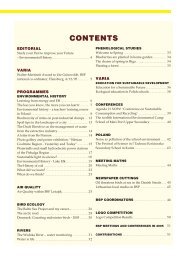newsletter_2008_1.pdf - 5.84 MB - The Baltic Sea Project
newsletter_2008_1.pdf - 5.84 MB - The Baltic Sea Project
newsletter_2008_1.pdf - 5.84 MB - The Baltic Sea Project
Create successful ePaper yourself
Turn your PDF publications into a flip-book with our unique Google optimized e-Paper software.
In Emajõe Park the air is polluted, which isn’t unusual,<br />
because the park is next to a busy street. In Emajõe Park<br />
there were no fir trees, so we studied Colorado Spruce<br />
(Picea pungens) instead. <strong>The</strong> results cannot be compared<br />
to those of the fir trees because the Colorado Spruce is<br />
more resistant than the fir tree.<br />
In Raadi Park we found a lot of different species of lichens;<br />
there were also some fructicose lichens which shows the<br />
air is clean. This result is also confirmed by the fir tree watch<br />
and the growth of tar spot fungus.<br />
Based on our observations we can say that the air in Raadi<br />
Park is the cleanest, which is presumably because it is in<br />
the suburbs.<br />
<strong>The</strong> attitude which We should take<br />
when looking at asia<br />
from various Wiewpoints<br />
Authors: Akane Aoki, Eri Adachi, Tmotaka Isono, Ryohei<br />
Itsuaki, Nana Kifushi, Yukiko Kishimoto, Anna Kunimatsu,<br />
Yuka Nishizaki, Satomi Minagawa<br />
Teachers: Naohiro Ii, Masako Nakamura<br />
Ikeda Senior High School attached to Osaka Kyoiku<br />
University, Japan<br />
Currently, we are working on ESD (Education for Sustainable<br />
Development) in our integrated studies classes in school.<br />
<strong>The</strong> first year group of senior high school will have this<br />
lesson for one hour a week, and the second year group will<br />
have it for two hours. Though not every school works on<br />
ESD, all of the students in our school work on this topic,<br />
as it is one of the ASP schools. <strong>The</strong> themes of the study are<br />
environment, human rights, poverty, peace, multiculturalism,<br />
biodiversity, endangered species, health, women’s<br />
equality, and agricultural development.<br />
Having studied all these topics, we would like to make<br />
a presentation about our thoughts on environmental<br />
issues in Asia from various viewpoints. <strong>The</strong>re was a famous<br />
speech by Severn Suzuki at the Earth Summit in Rio in 1992,<br />
about the environment, poverty, the divide of economic<br />
power and other issues. After taking a closer look at her<br />
speech, we realized that there are several points that relate<br />
to issues happening in Japan and other Asian countries<br />
today. <strong>The</strong>refore, we wanted to explain these, using specific<br />
examples and showing a diagram of the vicious circle<br />
which we compiled. We then came up with a solution on<br />
how to break this vicious circle, and we also compiled a<br />
report from Asia’s point of view bearing the problems of<br />
Japan, our homeland, in mind. Finally, we reached the con-<br />
clusion that what we really need to do is reduce the divide<br />
between the socially vulnerable and socially invulnerable.<br />
View points<br />
● Different opinions between developed countries and<br />
developing countries.<br />
● Destruction for survival.<br />
● Conflicts in emerging from poverty.<br />
● Poverty caused through robbing necessity for living.<br />
● Environmental destruction for countries’ own personal<br />
gain.<br />
● Grabbing resources from others.<br />
● Conflicts caused by environmental destruction.<br />
● Scramble for limited resources causing conflict.<br />
● Sharing happiness<br />
● <strong>Sea</strong>rching for happiness for the Earth<br />
● Individuals’ search for profit<br />
Biological Diversity<br />
in the natural Environment<br />
EvENTS<br />
Authors: Gatis Brikmanis, Didzis Dobelis<br />
Teacher: Lilita Skulte<br />
Aizpute Secondary School, Latvia<br />
Aim of the project: to make a training film about biodiversity<br />
and the possibility of preserving nature in its natural<br />
environment near Dzintere’s castle mound.<br />
Tasks of the project:<br />
● to find information about biodiversity in river areas,<br />
and aspects which help ensure this;<br />
● to survey the territory;<br />
● to establish the species of fish, plants, birds and trees;<br />
● to consult with ornithologists and fishermen; to make<br />
an informative film and educational material.<br />
9





